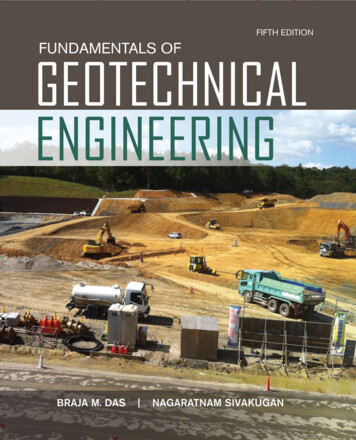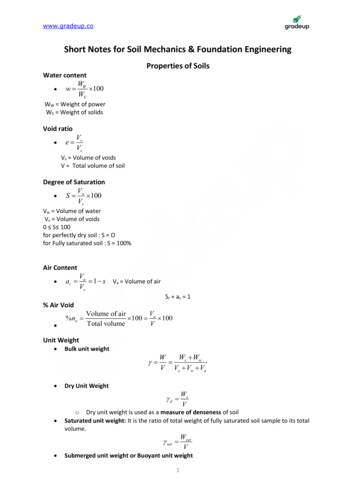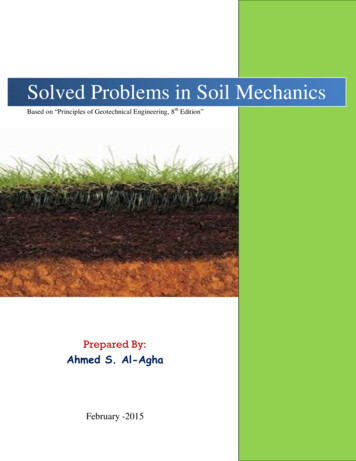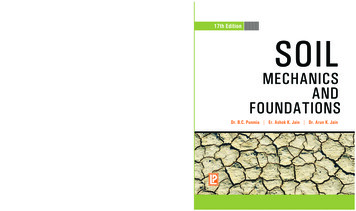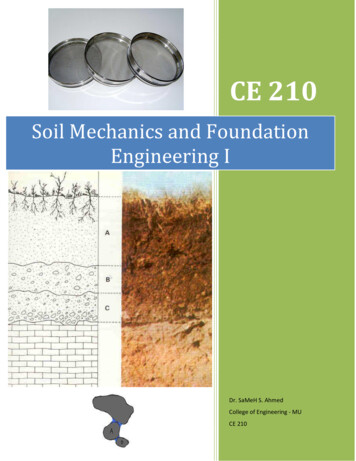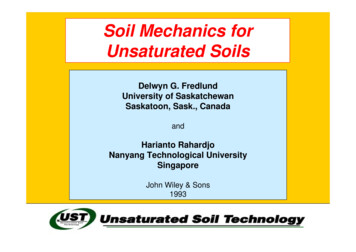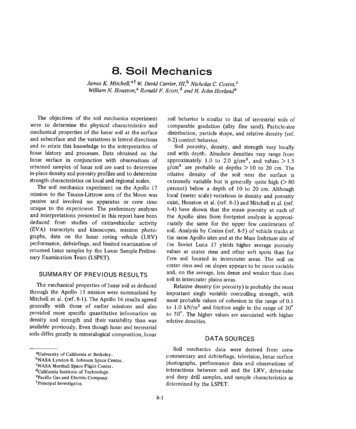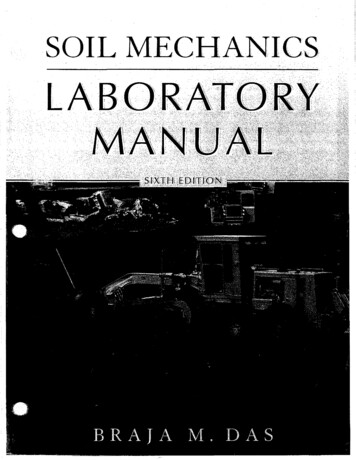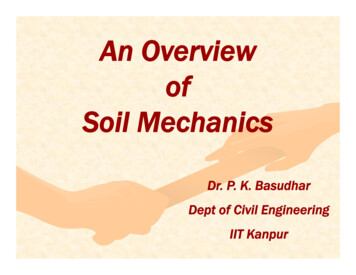
Transcription
An OverviewofSoil MechanicsDr. P. K. BasudharDept of Civil EngineeringIIT Kanpur
Soil Problems&SolutionsA Preview ofSoil BehaviorPioneers inSoil Mechanics
WHERE ?CIVIL ENGINEERENCOUNTERS SOIL AS A– FOUNDATION– CONSTRUCTION MATERIAL SOIL RETAINING SPECIAL PROBLEMSSOIL
FOUNDATIONS WHAT ARE FOUNDATIONS? TYPES OF FOUNDATIONS– SHALLOW FOUNDATIONS– DEEP FOUNDATIONS MAIN PROBLEM IN THE DESIGN– TO PREVENT SETTLEMENT TOTAL SETTLEMENT DIFFERENTIAL SETTLEMENT
SHALLOW FOUNDATIONS Structural loads arecarried by the soildirectly under thestructure
DEEP FOUNDATIONS Used to carryca y thet eloads to firm soil atpsome depth
Classic case of bad foundation Fig.Figg. shows the Palacio de lasBellas Artes, Mexico City The2mdifferentialsettlement between the streetand the building on the rightnecessitated the steps whichwere added as the settlementoccurred The general subsidence ofthis part of the city is 7 m (Photograph compliments ofRaul Marsal)
Example of Shallow foundations Fig shows the MITstudents centre Mat foundation Floatation technique
Main Factors1. Just how deep into the soil should the building beplaced?2. Would the excavation have to be enclosed by a wallduringg construction to pprevent cavecave--ins of soil?3. Would it be necessary to lower the water table inorder to excavate and construct the foundation and,if so,so whath t meansme ns shouldsho ld be usedsed to accomplishomplish thislowering of the ground water (dewatering)?4. Was ttheree e a dadangerge oof dadamageage to adjaceadjacentt bbuildings?d gs?5. How much would the completed building settle andwould it settle uniformly?6. For what stresses and what stress distribution shouldthe mat of the building be designed?
Example of Deep foundations MIT material centre hasdeeppppile foundation Reasons– Basement space notdesirable– No sand and gravel attheh sitei– Not to disturbunderground utilities Point bearing pile Friction pilep Augering
Main FactorsI What type of pile should be used?I.2. What was the maximum allowable load for a pile?3 At what3.h t spacingp in shouldh ld ththe pilpiles bbe dridriven?n?4. How should the piles be driven?5. How much variation from the vertical should bepermitted in a pile?6. What was the optimum sequence for driving piles?7. Would the driving of piles have an influence onadjacent structures?
Example of Embankmenton Soft Soil 10.10.7 m embankmenton a 9.8m layer ofsoft soil Preloading technique Shear rupture shouldnot occur
Main Factors1. How high a fill could be placed?2. How fast could the fill be placed?3. WhatWh t werer theth maximumm im m slopesl p forf r theth fill?4. Could the fill be placed without employing specialt h itechniquest containtot i or draind i theth softft foundationfd tisoil?5. HowH muchh wouldld theh fill settle?l ?6. How long should the fill be left in place in orderthath theh foundationfd ib compressedd enoughbeh topermit construction and use of the tank?
Example of Foundation Heave Occurs when foundation soil expands when theconfining pressure is reduced and / or the water contentof the soil is increasedg Arid regions Presence of montmorillonite
Main Factors Proper size ,capacity,capacity length and spacing of thepiles The pile should be long enough to extend belowthe depth of the soil that would expand TheTh depthd h selectedld ini suchh a way thath thehconfining pressure from the soil overburdenpluslminimumi iloadl d isi sufficientffi ito preventexpansion
CONSTRUCTION MATERIAL Select proper type of soilMethod of placementControl of actual placementFillingg
Example of an Earth Dam Two main zones– Clayy core– Rock toe Gravel filter Rock facing Zoned earth dam & homogeneous earth dam
Main FactorsI. What should be the dimensions of the dam to give the mosteconomical, safe structure?2. What is the minimum safe thickness for the gravel layers?3. How thick a layer of gravel and rock facing is necessary tokeep any swelling of the clay core to a tolerable amount?4. What moisture content and compaction technique should beemployed to place the gravel and clay materials?5. What are the strength and permeability characteristics of theconstructed dam?6. How would the strength and permeability of the darn varywith time and depth of water in the reservoir?7. How much leakage would, occur under and through the dam?8. What,Wh if any, speciali l restrictionsi ion theh operationioff thehreservoir are necessary?
Example of a Reclamation Structure NonNon-availabilityy ofgood building sites Harbor and terminalfacilities Hydraulic filling
Main FactorsI. How deep should the sheet pile wall penetrate the foundationsoil?2. How should these piles be braced laterally?3. What is the most desirable pattern of fill placement i.e., howshould the exit of the dredge pipe be located in order to getthe firmer part of the fill at the locations where the maximumfoundation loads would be placed?p4. What design strength and compressibility of the hydraulic fillshould be used for selecting foundations for the tanks,buildings,g , and pumpingp p g facilities to be pplaced on the island?5. Where did the soil fines in the dirty effluent which went out ofthe island over the spillway ultimately settle?
Example of Highway Pavement Most common use of soil asconstr ction materialconstruction Pavements– Rigid– Flexible
Main Factors1. How tthickc sshouldo d tthee variousva o s cocomponentspo e ts oof ttheepavement be to carry the expected loads?pmixture of additives for2. What is the optimumstabilizing the desert sand?3. Is the desert sand acceptable for the construction ofthe wearing surface?4. What grade and weight of available asphalt maketheh most economical,i l satisfactoryifwearingi surface?f ?5. What type and how much compaction should beused?sed?
SLOPES AND EXCAVATIONS(a) Natural Slope(c) Excavation for Pipe(b) Excavation for Building(d) Canal
UNDERGROUND AND EARTHRETAININGTSTRUCTURESTT SoilSoil--structure interaction Examples– PipePi shellsh ll– Basement walls of the building– Sheet pile wall– Tunnels– Drainage structures
Example of Earth retaining structure Anchored bulkhead Take care of lateralstressestr Stability against shearrupture
Main Factors1. WhatWh t typet p off wallll (material(m t ri l andnd crossr section)ti n) shouldh ld beb used?d?2. How deep must the wall penetrate the foundation soil in order toprevent the wall from kicking out to the left at its base?3. AtA whath heighth i h on theh wallll shouldh ld theh anchorh tiei beb located?ld?4. How far from the wall should the anchor tie extend?5. What type of anchoringg system should be employed at theonshore end of the anchor tie? (One way to anchor the wall is touse a large mass of concrete, i.e., dead manman. Another way is to usea system of piles ;including some driven at a slope with thevertical;; such a sloping pile is termed a batter pile)vertical6. What was the distribution of stresses acting on the wall?7. What type of (drainage system should be installed to prevent allargediffdifferentiali l water pressure fromfd l i on thedevelopingh insidei id offthe wall?8. How close to the wall should the loaded crane (578 kN whenf ll loaded)fullyl d d) beb permitted?pitt d?9. What restrictions, if any, are necessary on the storage of cargo onthe area back of the wall?
Example of Buried Pipeline FlexibleFl ibl andd RigidRi id PipesPip Failures– Faulty construction– Excess construction load– Sagging of pipe Select– Properp thickness of thepipe wall– Workout and supervisetheh installationill i
SPECIAL PROBLEMS VibrationsExplosions and earthquakesSStorageoff industriali d i l fluidsfl id ini earthh reservoirsiFrostRegional subsidence
Oil storage
Frost Heave
SOLUTIONSSOIL MECHANICSStress-strainproperties Theoreticalanalyses forsoil massesGEOLOGY,EXPLORATIONComposition of actualsoil massesEXPERIENCEECONOMICSENGINEERINGJUDGEMENT
Why Soil problems are UNIQUE?1. Soil does not possess a linear or unique stressstress-strainrelationship2. Soil behavior depends on pressure, time, andenvironment3. TheTh soilil att essentiallyti ll every locationl ti isi differentdifft4. In nearly all cases the mass of soil involved is underunder-ground and cannot be seen in its entirety but must beevaluated on the basis of small samples obtainedfrom isolated locations5. MostMsoilsil are very sensitivei i to disturbancedi bffromsampling, and thus the behavior measured by alaboratoryy test mayy be unlike that of the in situ soil
An Overview Particulate Nature of Soil Nature of Soil Deformation Role of Pore Phase¾ Chemical Interaction¾ Physical Interaction¾ Sharing the Load A brief look at Consolidation
Particulate Nature off Soil Soil is composed of microscopic or macroscopic discreteparticles, which are not strongly bonded together as crystals Soil particles are relatively free to move with respect to another,pless fluent than the movement of fluid particles Particulate system pertains to a system of particles, and thescience dealing with the stress-strain behavior of soils is referredas Particulate Mechanics
Nature of Soil Deformation Contact forces develop due toapplied forces Contact forces are resolved intonormal N and tangential T forces The usual types of deformation inthe vicinity of contact forces¾ Elastic strain¾ Plastic strain¾ ParticleP i l crushinghi underd highhi h stress
Contact area enlarges due tothe deformations,deformations and thus thecenter of the particles comecloser (Fig. a) Plate like particles bend toallowllrelativel imovementbetween adjacent particles((Fig.g b)) Interparticle sliding occurswhen the shear force at thecontact surface exceeds theshear resistance of soil particle(Fig. c)
Overall strain of a soil mass is the combined effect of particledeformation and interparticle sliding.sliding Relative sliding of soil particles result in rearrangement of soilparticles , which is a nonlinear and irreversible phenomena, thusresulting in a non-linear and irreversible stress-strain behavior ofsoils. FFrictionali til andd adhesiondh i forcesfare alsol effectiveff ti ini producingd iparticle deformation There are 5 million contacts within 1 cm3 of sand mass. Hence,defining stress-strain relation of soil at each of the contacts isimpossible, and thus one has to rely on experimental results
If the box has rigid walls, andthe vertical load is increased,increasedthe soil particles will nestlecloser and closer. This is calledVolumetric Compression Slidingg failure will occur atindividual contacts, but the soilmass will not undergo anoverall shear failure Removal of the load will resulti Expansion or Swell off soilinilmass through a reverse processdue to rearrangement ofparticles
If the box has flexible walls,,the entire soil mass willundergo an overall shearfailure The load at which failureoccurs is called the ShearStrength of Soil Shear strength is determinedby the resistance to slidingbetween particles movinglaterally to each other
Role of Pore Phase : Chemical Interaction The spaces among the soil particles are calledPore Spaces The spaces are usually filled with air and/or water(with or without dissolved matter) Soil is a Multiphase system¾ Mineral Phase (Mineral Skeleton)¾ FluidFl id PhasePh(P(PoreFl id)Fluid) Pore fluid influences the magnitude of the shearresistance existing between two particles byintroducing chemical matter to the surface ofcontact Pore fluid intrudes particle spaces and acts intransmission of normal and tangential forces
Role of PorePo e Phase : Physical InteInteractionaction Hydrostaticycondition of waterpressure The pressure in the pore waterat any point is equal to the unitweight of water times thedepth of the point below thewater surface In this case, there is no flow ofwater
Water pressure at the base ofbox is increased, whileoverflows hold the watersurface constant Upward flow of water takesplace, the amount of which iscontrolled by excess pressureat base and Permeability of thesoil mass The more the permeable a soil,the more water will flow for agiven excess pore pressure
If the excess water pressure atthe base is increased, a pressurewill be reached where the sandwill start to flow upwards alongwith the upward flowing water ItiscalledQuicksandcondition or Sand Boiling The soil will occupypy ggreatervolume than initial state, andhas less shear strength thannormal condition
Changes in volume and shearstrength come about due tothe changes in contactpressurebetweentheparticles Contact forces are related tothe difference between thestress pressing downward(Total Stress) and the PorePressure This difference is defined asthe Effective Stress
Rolel off Pore Phaseh : Sharingh i theh Loadd As soil is a multiphase system, the load applied to a soilmass wouldld beb carriedi d ini a part byb theh mineralil skeletonk landdpartly by the pore fluid The sharing of the load is analogous to the partial pressurein gases, and is well simulated by the HydromechanicalModel for load sharing and consolidation.
Fig (a) shows a cylinder ofsaturated soil The porous piston permits loadto be applied to saturated soiland yet permits escape of thefluid from the pores of the soil
Fig(b)showsahydromechanical analog inwhich the properties has beenlumped The resistance of the mineralskeleton to compression isrepresented by a spring The resistance to the flow ofwater through the soil isrepresented by a a valve in anotherwise impermeable piston
Fig (c) represents a load applied tothe piston of the hydromechanicalanalog but the valve is kept closed The piston load is apportioned by thewater and the spring The piston will be moved very littleas theth watert isi nearlyl incompressble.iblThe spring shortens very slightly as itcarries a veryy little load Essentially all of the applied load isresisted by an increase in the fluidpressure within the chamber
Fig (d) shows the valve to beopened As water escapes, the springshortens and begins to carry asignificant fraction of the loadapplied There is a corresponding decreasein pressure in the chamber fluid
Figg ((e)) shows a condition inwhich all the applied load iscarried by the spring The pressure in the water hasreturned to the originalhydrostatic condition Now, there is no further flowof water
A limited amount of water can flow out through the valve atany interval of time The process of transferring load from water to the spring is agradual process, which is shown in Fig (f)
This process of gradual squeezing out of water from thepore spaces of soil mass is call Consolidation The time interval involved in the above mentionedphenomena is called Hydrodynamic Time Lag The amount of compression that has occurred at any time isrelated to the applied load and also to the amount of stresstransmitted at the particle contacts i.e. to the differenceb tbetweenth appliedtheli d stresstandd theth pore pressure. ThisThidifference gives the concept of Effective Stress
The most important effect of Hydrodynamic Time Lag isthe delayed settlement of structures
Consolidation The time required for consolidation process is related to ::¾ The time should be directly proportional to the volume of watersqueezed out of the soil. The volume of water is related to theproduct of stress change,change the compressibility of the mineralskeleton, and the volume of the soil¾ TheTh timei shouldh ld beb inverselyil proportionali l to howh fastf theh water canflow through the soil. The velocity of flow is related to the productof the permeability and the hydraulic gradient. The gradient isproportionalti l tot theth fluidfl id pressure lostl t withinithi theth soilil divideddi id d byb thethdistance of the flow path of the fluid.
t (Δ σ )(m )(H )(k )(Δ σ / H )where, t The time required to complete some percentage ofconsolidation process Δσ The change in the applied stress m TheTh compressibilityibilit off theth mineralil skeletonk l t H The thickness of the soil mass (per drainage surface) k The permeability of the soil
The time required to reach a specified stage in theconsolidation process is given by ::mHt k2The above relation suggests that the consolidation time : Increases with increasing compressibility Decreases with increasing permeability Increases rapidly with increasing size of soil mass Is independent of the magnitude of the stress change¾ Soils with significant clay content requires long time forconsolidation – from one year to many hundreds of years¾ Coarse granular soils consolidates very quickly, in a matterof minutes
Consequences off Particulatel Natureof Soils
1st ConsequenceThe deformationThd fi off a mass off soilil isi controlledll d bybinteractions between individual particles, especiallyby sliding between particles
2nd ConsequenceSoil is inherently multiphase,multiphase and the constituents ofthe pore phase will influence the nature of themineral surfaces and hence affect the processes offorce transmission at the particle contacts
3rd ConsequenceWater can flow through the soil and thus interactwith the mineral skeleton, altering the magnitude ofthe forces at the contacts between particles andinfluencing the compression and shear resistance ofthe soil
4th ConsequenceWhen the load applied to a soil is suddenly changed,the change is carried by jointly by the pore fluid andby the mineral skeleton. The change in porepressure will cause water to move through the soil,hhenceth propertiestheti off theth soilil willill changehwithithtime
¾Consolidation Theory¾Foundation Design andConstruction¾CofferdamC ff d analysisl i¾LLandslide MechanismsMmFamous BookFrom TheoryFThtotPractice in SoilMechanicsKARL VON TERZAGHI(1883 - 1963)Father of Soil Mechanics
¾ Fundamentals of soilmechanics.¾ Consolidation¾ Shearhstrengthh offcohesive soils¾ Stability of earthslopespFamous BookFundamentals ofSoil MechanicsDONALD WOOD TAYLOR(1900 - 1955)
¾ Soil Classification¾ Seepage throughearthh structures¾ Shear StrengthgBest Teacher in TheHarvard UniversityyARTHURU CASAGRANDEC S G(1902 - 1981)
¾Application of soilmechanics to designand construction¾Evaluation andpresentation of theresults off research inform suitable forreadyy use byy thepracticing engineerFamous BookSoil Mechanics inEngineering PracticeRALPH BRAZELTON PECK (1912 - )
¾Fundamentals ofeffective stress¾Pore pressures inclays¾Bearing capacity¾Slope stabilityBest Teacher in TheImperial Collegeg in TheUniversity of LondonALECC WESTLEYSSSKEMPTONO(1914 – 2001)
¾Fundamentals of shearstrength¾Sensitivity of clays¾Stabilitybili off naturallslopesBest Teacher and theFirst Director in TheNorwegian GeotechnicalInstituteLAURITS BJERRUM(1918 – 1973)
¾Concepts of Active andPassive Earth Pressure¾Concept of Friction¾CoinedC i d theh term“Cohesion”AddressedAddd thehA dAcademyoffScience (Paris, 1773) presentinga modest "essay on theapplication of the rules ofmaxima and minima to certainstatics problems relevant toarchitectureCHARLES AUGUSTIN DE COULOMB(1736 - 1806)Grandfather of Soil Mechanics
¾Active and PassiveEarth Pressure theoriesEPioneer with ad tdeterminationi tiWILLIAM JOHN MAQUORN RANKINE(1820 - 1872)
¾Concepts in SlopeStability AnalysisGeotechnical , Trondheim,NorwayNILMAR JANBU(1920 - )
PIONEERING CONTRIBUTIONS on¾ Strength and compressibility ofcompacted clay soils¾ Strength and consolidation of naturaldeposits of soft clay¾ Cracking of earth dams¾ Frost action¾ Flexible and rigid pavement design¾ Analysis of buried conduits¾ Pile foundations,, stabilityy of slopespand embankments on soft clays¾ Stress-deformation and liquefactionof sand, and methodologies forinvestigating failuresGERALD A. LEONARDS(1921 – 1997)
1.Engineer of the Year (Georgia Society ofProfessional Engineers), 19732. The Herschel Prize (The Boston Society ofCivil Engineers),Engineers) 19763. The ASCE Middlebrooks Award, 19774. The Terzaghi Lecture, 19795 The ASCE Martin Kapp Lecture in New Y5.York,rk19856. The Brooks Award, 19907 Elected to The National Academy of7.Engineering, 19948. The ASCE Middlebrooks Award, 19949. ASCE Forensic Engineergof the Year Award,199410. The ASCE Terzaghi Award, 1995Heck of an Engineerg&A Master of AnecdotesGEORGE F.F SOWERS(1921 - 1996)
¾ Mechanics of PileFoundations and Soil-PileInteraction Analysis¾ Soil Compaction¾ Analytical Methods inPavement Design¾ Analytical and experimentaltechniques of earthquakeengineeringFather of GeotechnicalEarthquake EngineeringHARRY BOLTON SEEDAugust 19, 1922 — April 23, 1989
¾ Appropriate methods of calculationfor Seismic Design of Foundations¾ free Torsion Vibrating Pendulum todetermine the dynamical properties ofsoil¾ ResonanceRperiodi d off ththe subsoilb il¾ Coastal Engineering and DewateringSystemy¾ Highly compressible soilsFamous BookkFoundationou dat o Engineeringg ee gfor Difficult SubsoilConditionsLEONARDO ZEEVAERT WIECHERS
Soil particles are relatively free to move with respect to another, less fluent than the movement of fluid particles Particulate system pertains to a system of particles, and the science dealing with the stress-strain behavior of soils is referred as Particulate Mechanics.File Size: 2MB



